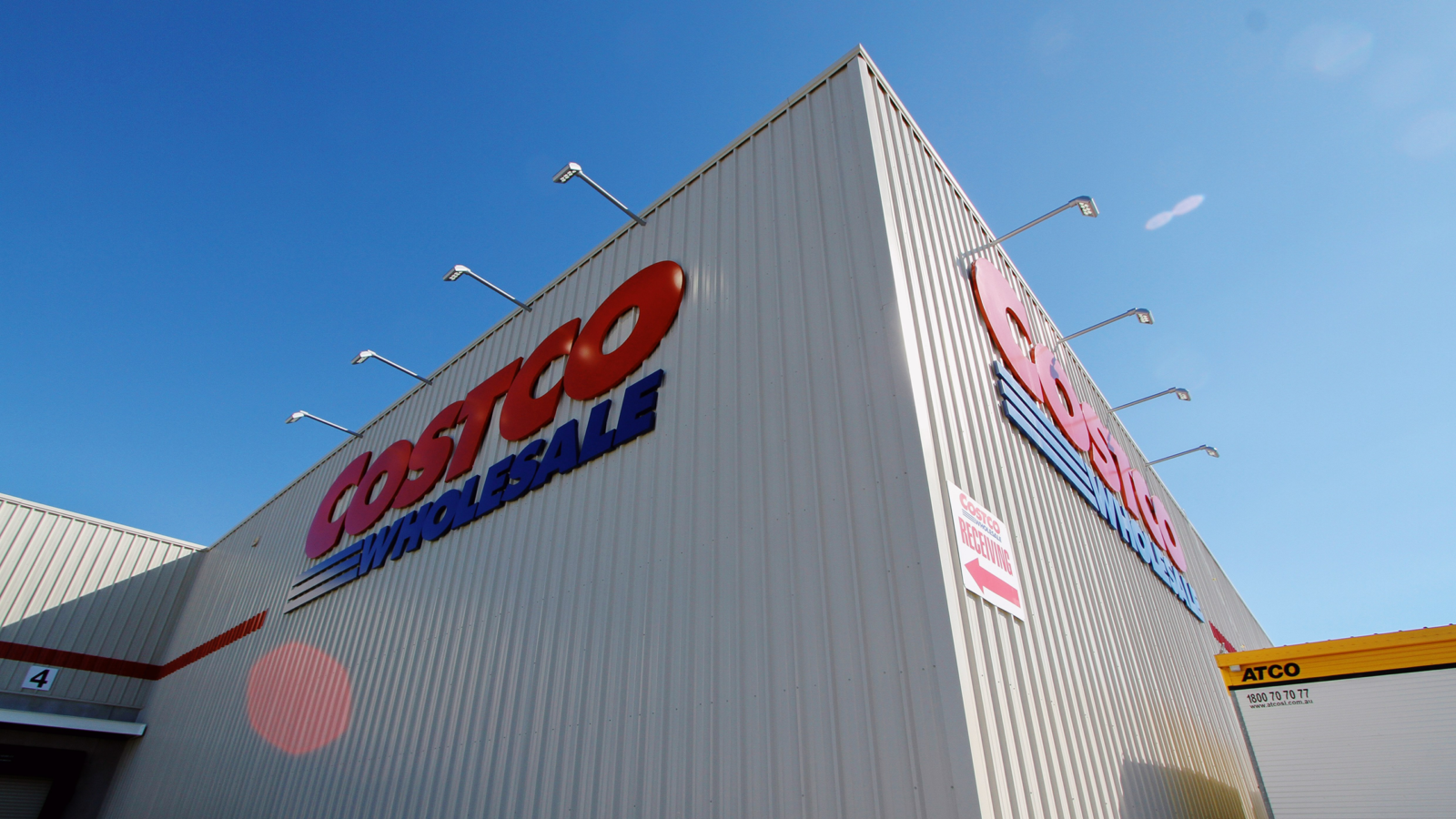Good morning and happy Monday.
The Justice Department has opened a probe into the soaring price of eggs in America, The Wall Street Journal reported Friday. Investigators trying to crack the case plan to look at whether major egg producers have coordinated to hike prices or reduce supplies in an effort to poach profits, the newspaper said.
Bureau of Labor Statistics data released last month showed egg prices had risen 53% year-over-year and a whopping 15.2% in January alone, amounting to the biggest spike in a decade.
Here’s hoping this IRL episode of CSI: Des Moines will put an end to the consumer shell shock.
Whipsawing Trade Policy Sows Uncertainty in Big Box Retail

Bing Crosby’s Great Depression era anthem “Brother, Can You Spare a Dime?” is probably hitting Corporate America’s Spotify rotation after more of POTUS Trump’s America First trade policies landed on Tuesday.
A slew of earnings reports last week from the consumer discretionary sector raised the specter of sapped spending as executives discussed the possibility of increasing prices on goods to offset the costs of tariffs on shipments from Canada, Mexico, and China. By the end of the week, President Trump punted, delaying import duties on some goods from Mexico and Canada after US equity indexes flashed red. Yet his strategy is reminiscent of the 1930s-era trade protectionism that some economists say exacerbated the Great Depression.
History Lesson
The Smoot-Hawley tariff bill was devised to support struggling US farmers and focused on agricultural imports. Aggressive lobbying from businesses expanded the scope to a variety of imports from sauerkraut and clothespins to goldfish and fountain pens by the time President Hoover signed the bill into law in 1930. Retaliatory tariffs killed exports. Global trade sank. And American consumers ultimately paid the price.
Trump 1.0 trade policy also came with consequences. When tariffs were applied to washing machines in 2018, prices climbed 12% for American consumers, according to a research paper authored by a pair of University of Chicago professors and a Federal Reserve Board economist. Some 1,800 new jobs were created, but the average annual cost to consumers was over $815,000 per job created, according to the paper.
Trump 2.0’s trade war — larger in scale, broader in scope, and implemented more quickly than the duties imposed during his first term — could be felt by American households more keenly this time.
Yale Budget Lab’s analysis of Trump 2.0 tariffs as of Tuesday estimates personal consumption expenditures will rise by 1% in the short-term to 1.2% under full retaliation, or the equivalent of an average per-household consumer loss of $1,600 to $2,000 in 2024 dollars (That was assuming immediate effectiveness of tariffs). Electronics and clothing are disproportionately affected, while cars and food would also see above-average price hikes, the group said. After consumers shift their spending habits because of price increases, the loss per household settles at about $1,100 to $1,400.
Big-box retailers Target, Best Buy, and Costco said they are staying flexible in what they described as a complex and fluid situation:
- Target said it is committed to providing affordability but forecast a wide range of potential scenarios for the year. CFO Jim Lee explained: “What we don’t know is potential consumer demand — that’s across the board, based on how tariffs ripple across the economy.
- Best Buy CEO Corie Barry said price increases for American consumers are “highly likely” because the electronics store’s vendors will pass on some of their tariff costs to retailers. Costco chief Ron Vachris had his own not-so-sunny assessment: “When it rains, it rains on everyone.”
Rainy Days and Mondays: Fortunately, the US economy is a lot sunnier than it was when Smoot-Hawley was enacted, but if President Trump ignores market signals, you might consider grabbing an umbrella.
Own Shares In One Of The “World’s 50 Best Bars”

What started as a single bar in New York is now expanding to Nashville, Atlanta, Seattle, and other major cities — and you have the opportunity to invest as it all comes to life.
Death & Co is defining modern hospitality, driving $14M in annual revenue and projecting 170% top line growth this year alone. With award-winning books and placements on multiple “World’s 50 Best Bars” lists, they’re uniquely positioned for strategic (and exponential) growth.
They’re giving readers a unique opportunity to participate in their latest funding round. Perks include $12 cocktails for life, exclusive events, and even a drink named after you.
The $12 perk offer ends in less than 3 days—at midnight on 3/12—don’t miss your chance to own a piece of the $750B hospitality industry.*
TikTok Still Doesn’t Have a Buyer
The clock is ticking on a TikTok sale… and yet nobody at parent company ByteDance seems to care.
We’re now less than one month away from the April 5 sale-or-ban deadline President Trump gave TikTok when he granted a 75-day extension upon arriving back at the White House in January. And last week, Axios reported that ByteDance hasn’t even held negotiations with any prospective buyer yet. So what is going to happen to everyone’s favorite time-waster-slash-hypothetical-apocalypse-level-national-security-threat?
No Bytes Yet
Make no mistake: ByteDance may be refraining from taking offers, but there are plenty of buyers still licking their chops. Last week, Wyoming billionaire and noted Trump supporter Reid Rasner floated a $47.5 billion bid for the app. He joins a list of suitors that includes Frank McCourt, Oracle, Microsoft and… the US government? That’s right: The Trump administration has floated the idea that its proposed US sovereign wealth fund could take a significant stake in the app.
And yet, ByteDance isn’t biting yet. One possible reason? Even a nearly $50 billion offer may be a significant undervaluing of the app. At least, that’s what a few recent clues would suggest:
- Last week also delivered a batch of unsealed documents from a lawsuit against the company in Washington state, which revealed that its TikTok Live e-commerce platform generated $1.7 billion in sales in a single quarter in 2023, including $400 million from the US. TikTok projects annual sales to reach $77 billion by 2027.
- ByteDance last week also launched a new share-buyback program for US employees, offering to buy shares at almost $190 a pop — up from a $181 per-share offer six months ago — which would value all of ByteDance at around $315 billion.
Meanwhile, back in February, Bloomberg reported that some American investors in ByteDance are arguing that the company doesn’t need its US unit at all — given that its presence in China accounts for 80% revenue and most of its growth.
Another reason for the stalled sale talks? Even this extended deadline — which, remember, the Trump administration had no legal basis in ordering in the first place — appears pretty loose. On Thursday last week, the president said he’d “probably” extend the deadline if a deal is not hammered out in time. Given that the administration’s rollout of tariffs hasn’t exactly been firm, swift or smooth, it’s possible ByteDance is simply playing deadline chicken.
Waiting in the Wings: TikTok’s biggest competitors, meanwhile, have been a beehive of activity as the app sits in legal limbo. YouTube integrated its video-generating AI model into Shorts in February. And, according to a report from The Information in late February, Instagram is considering spinning out Reels — a.k.a., the platform’s TikTok-esque vertical video feature — into its own separate app. Rest assured, one way or another, we’ll all be able to keep wasting an hour or two of our lives, one 90-second video at a time. We love the smell of freedom in the morning here at The Daily Upside.
Lead The Future Of Tech—One Insight At A Time. The role of CIOs and IT leaders isn’t just evolving—it’s accelerating. Staying ahead means cutting through the noise and focusing on what truly matters. That’s why we launched CIO Upside, a new newsletter from The Daily Upside, delivering actionable insights on the latest trends, innovations, and strategies shaping the future of technology leadership. Join thousands of forward-thinking tech leaders who rely on CIO Upside to stay ahead. Subscribe for free today!
Farewell (For Now, At Least) to Tesla’s $700 Billion Trump Bump
It’s not always a lucky number.
Tesla’s stock closed down for a record seventh consecutive week on Friday, and has nearly erased a $700 billion post-election rally. While the increasingly scrutinized role of CEO Elon Musk in the federal government is one factor, it is — to borrow a phrase from James Carville — the electric vehicle market, stupid, that’s causing the biggest concerns for investors.
A World of Pain
After President Donald Trump won the November election, investors excitedly hopped on board Tesla like a family cramming into a Model Y for a beach vacation. The premise was simple: Musk’s firm, with its CEO as the president’s chief benefactor and trusted advisor, was positioned to reap a windfall. Already a dominant player in the electric vehicle space, it also had a heavily publicized autonomous vehicle technology rollout on the horizon, one that access to the levers of government could certainly help with.
That bet has, so far, been a bust. Tesla’s stock shed 28% in February, the second-worst month in its history (by comparison, the S&P 500 lost just 2% last month). Musk’s role as a senior White House advisor, which has put him in charge of dramatic federal spending cuts, has led to concerns about potential reputational pitfalls. Not since Leatherface has anyone been so closely associated with an oversized chainsaw. Tesla, however, has sustained even more painful blows — in the global electric vehicle market that is the source of its cash flow. Data increasingly shows not one, not two, but at least three major markets shifting gears and turning away to competitors:
- Data released last week showed Tesla’s sales of China-made electric vehicles fell 49% year-over-year in February to 30,000, or the lowest point in over two years. In the same year-over-year time period, electric vehicle sales in China rose 82%.
- A similar trend is underway in Europe: According to the European Automobile Manufacturers’ Association, only 9,945 new Tesla EVs were registered on the continent in January, a 45% decrease from 18,161 last year. Overall EV sales rocketed 37% at the same time, suggesting strong demand that Tesla is failing to capture. And, in Australia, Tesla sales fell 72% year-over-year in February.
What the Street Says: At least two leading Wall Street firms slashed their price targets for the Musk-led company last week, meaning they think Tesla’s issues aren’t going to be fixed any time soon. Robert W. Baird cut its outlook on Tesla by 16% to $370, noting the recent data indicating sliding sales “lead us to believe there is risk to the consensus Q1 delivery estimate” of 437,500 vehicles. Bank of America slashed its price target 22% to $380, citing slower European sales and worries about “the brand potentially souring.”
Extra Upside
- Waiting Game: Federal Reserve Chair Jerome Powell said Friday that the central bank is awaiting “greater clarity” on government policies before tinkering with interest rates — markets are betting on three rate cuts this year, starting in June.
- In Deep Sh… Er, Trouble: US farmers, needing potash they buy from Saskatchewan, and Canadian farmers, needing phosphorus they buy from Florida, are staring down a tariffs-driven fertilizer crisis.
- Coin Flip: Banks supervised by the Office of the Comptroller of the Currency given the go-ahead to engage in certain common crypto activities, agency says.
Just For Fun
Disclaimer
*This is a paid advertisement for Death & Company Regulation A offering. Past performance is not indicative of future results. Please read the offering circular at invest.deathandcompany.com

